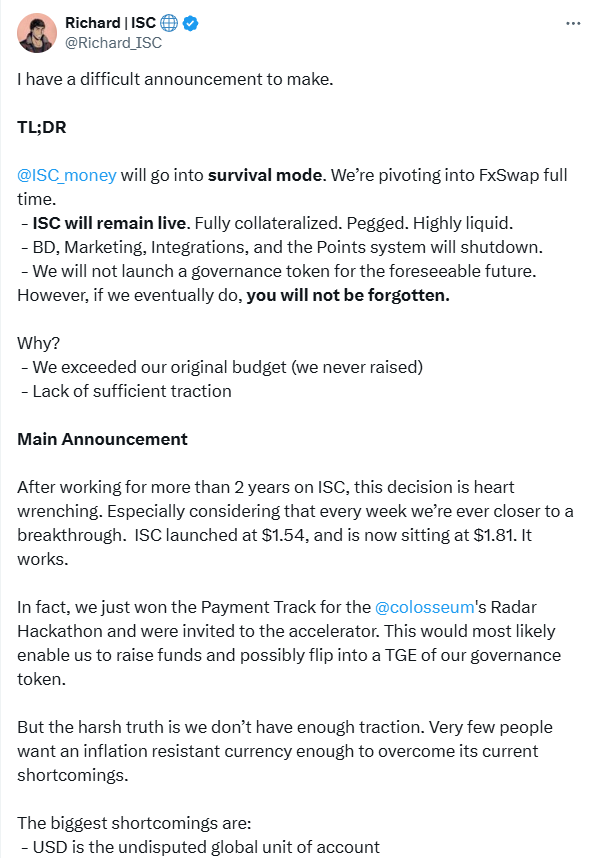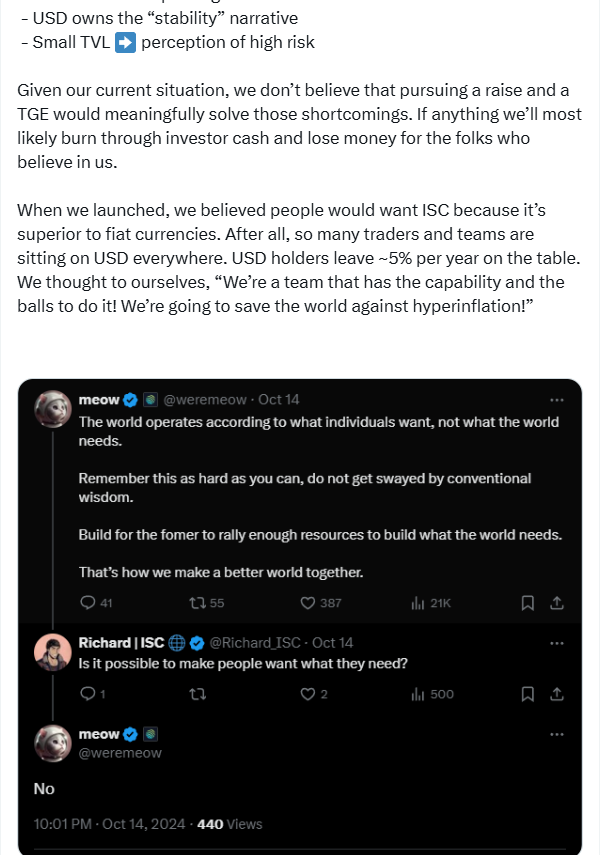Growing Stablecoins & The Path Of Greatest Resistance
The Impossible Is Simply Many Variables, All At Once
Building a stablecoin is difficult.
Stably growing a stable stablecoin is far mor difficult.
In this blog I want to consolidate my thoughts on why it is so difficult, and what the conditions are for a thriving stablecoin.
The Difficulties
As far as I can tell, every stablecoin has a set of difficulties that will forever plague them. You cannot escape these difficulties, and before you can even grow, the prerequisite of solving these problems (even partially) is a must. Here is the list:
Maintaining the Peg: A stablecoin must remain at peg to be trusted. This goes without saying, but without any Lindy effect in your favor, like DAI, USDC, or USDT, individuals are more wary of holding the stablecoin. Any sign of a depeg can cause a large capital flight. Even if the system is overcollateralized, you drastically shrink your revenue-generating base as the overall supply decreases.
Strong Liquidity: A stablecoin must have strong liquidity tied to relevant assets to be useful. At the heart of overcollateralized CDP-style vault stablecoins is the demand for leverage. Users lock up ETH, wBTC, stETH, etc., and open up a loan (in the form of a stablecoin) against their collateral. If your stablecoin has poor liquidity tied to the asset they want to go long on, you will lose the customer. They won't use your product, or they might realize too late how bad your product is compared to others due to slippage.
Unfair Advantage: To outcompete incumbents, you need to offer some unfair advantage. New projects generally suffer from poor liquidity, low adoption rates, and limited interoperability. Thus, new stablecoins are forced to compete on yield or cost, both of which are expensive. Your small fledgling protocol with minimal revenue is now spending money just to attract liquidity or debt buyers. Lowering your interest or borrowing rates decreases your margins and risks depeg due to saving rate arbitrage.
Integrations: A stablecoin needs integrations for users to utilize it beyond yield farming. The fewer the utilities (payments, lending, swapping, leverage, etc.) available, the less reason someone has to acquire or mint the stablecoin. Acquiring these integrations can be costly. Partners are hesitant to spend incentives or development time on a low liquidity, high-risk stablecoin. Incumbent stablecoins have the red carpet rolled out, with USDC and USDT integrated and incentivized on day one.
Relevant Collateral: A stablecoin needs interesting and relevant collaterals, but being too creative can be detrimental. If a new stablecoin only has 1-2 collaterals (e.g., BTC and wETH), there is a large amount of untapped collateral in the broader market. However, the demand to meet this growing supply is risky. Allowing an asset with insufficient liquidity as collateral can introduce bad debt into a fledgling stablecoin desperate for adoption.
Compliance Posture: A stablecoin needs to decide its compliance stance and live with the long-term consequences. Whether it has a blacklist function, is backed by centralized assets like USDC and USDT, has privacy features, or decentralized governance—all these factors will play into future regulatory scrutiny. Early stablecoin protocols must balance how much they can afford to put into compliance versus the risks of not investing in it.
Security Risks: lest we forget, amidst solving all of these other variables, if a single line of code is exploitable, all collateral goes to 0 and devastatingly, everyone holding the stablecoin coin for its “stable” properties are rugged. While security risks are technically table stakes for DeFi, there is something particularly brutal about stablecoins that break. Perhaps that is my Terra/Luna PTSD talking.
Monetary Policy: US dollar interest rates run the world. They define the risk free savings rate and the amount of liquidity in circulation. Stablecoin protocols are always at risk of running to hot or too cold with the interest rates. There is a degree of speculation involved here, and there is plenty of monetary policy that suggests that a currency can only pick 2/3 options: exchange-rate stability, monetary policy autonomy, free flow of money and capital (no capital controls). In the case of DeFi because stablecoins are focused on exchange-rate stability and due to the nature of crypto the automatic selection of no capital controls as a policy, DeFi unfortunately surrenders it monetary policy autonomy. One of the potential work arounds of this is to choose a exchange-rate target that is detached from the largest powers at be. That is to say, choose an exchange-rate target that is neutral and non-manipulated.
Education: an expensive and difficult task that stablecoins have to carry is the constant process of education - why should you hold this dollar derivative stablecoin instead of something else? Users are used to $1 = $1, so having this new version of digital dollar that have different properties and risks, but are all apparently still worth $1 is rather confusing and scary. Throw stablecoin like SILK into the mix that are tracking a basket of currencies and commodities and you end up with even more leg work to build enough trust (and urgency) for a user to trust the stablecoin.
A Case Study - ISC
Recently, a stablecoin called International Stable Currency (ISC) entered into survival mode for many of the reasons listed above. ISC is unique to a lot of stablecoins due to its inflation resistant design. And despite its vast outperformance of USD, it failed to generate the needed traction to succeed.
While this could be perceived as the death knell of non-USD pegged stablecoins, I believe ISC serves to prove the thesis that growing and scaling a stablecoin (especially a unique one) is brutally difficult.
SILK - The Opportunity
Thus the paradox of stablecoins, because despite appearing to be a “simple” product, success is an elegant multifaceted accomplishment of overcoming not just the table stake difficulties, but also managing to show strength on a given category that makes you stand out from the crowd. The opportunity at play here is massive with $196B in stablecoins in circulation in DeFi. Do we truly believe that there will not be a unique stablecoin that will disrupt the current USD centered industry?
Our bet is that answer to that is “yes, it will be disrupted, and it will be SILK.”
I personally believe that while SILK still exhibits a variety of weaknesses, it is on the verge of having its breakthrough moment.
Integrations: unlike ISC, the SILK stablecoin has an entire interchain economy around it. ShadeSwap focuses on SILK pools, seamlessly allowing users to enter and exit SILK with dozens of interesting options. ShadeX will allow users to lend and borrow SILK, even using it as collateral. SILK Earn allow users to earn liquidations using their SILK. SILK staking empowers users to tap into a low risk savings rate that earns SILK with SILK. FINA debt cards empowers users to spend their SILK on every day transactions. Multiple LSTs built on top of Shade Protocol interact with SILK, making SILK a popular arb token to hold and use. In summary, unlike ISC and other flatcoins that are on an island in terms of integrations, Shade Protocol has built up an entirely unified economy around SILK to empower it to thrive
Omnichain Vision: we also hold that believe that in order to find more debt buyers you need to aggressively expand a stablecoin beyond a single chain. This means expansion of outposts, bridges, liquidity venues, fintech integrations, and ultimately support products around the stablecoin. SILK has all of these.
Monetary Policy: one of the biggest risks of flatcoins is that they appreciate too quickly in value against USD, making them undesirable for borrowers (who wants their debt to be rapidly appreciating in value against their position?). While SILK has seen aggressive USD appreciation, it isn’t as strong as other protocols (by design), making it more reasonable for borrowers to leverage.
Unfair Advantages: perhaps more important than anything listed is that SILK is private & basket pegged, making its value proposition incredibly alien to anything else that exists on the market. SILK as a currency is 10 years from the future, by by the time the future has arrived SILK will have the Lindy effect and have proven itself as the most resilient flatcoin ever created. That is to say that time is on SILK’s side. Similar to Bitcoin where its first mover advantage continued to build trust and momentum, we believe that SILK is in a similar position. Where will it be in 10 years?
One of our scarcer beliefs — compared to other on-chain economies — is our belief in data security. True adoption of DeFi hinges on robust data security measures. To attract billions in liquidity, both institutions and individuals will expect their onchain positions and asset movements to be encrypted by default, but auditable as needed.
At Shade, we believe that in the near future the total transparency of blockchain will be looked at with suspicion in the same way that a lack of data security would be viewed within our traditional financial markets. Another belief we have is in innovation through diversity. This doesn’t just mean a diversity of products built for a diverse set of global users. It also informs the approach behind SILK and its diversified collateral base. As on-chain economies grow, we all benefit from more experimentation with different compositions and use cases for stablecoins. We see tremendous synergies between SILK, dollar-backed stablecoins, other sovereign stablecoins, and commodities like BTC and metals.
Our mission is to integrate all of these beliefs into a seamless, omnichain economy that is secured by diverse assets and that powers off-chain and on-chain global commerce. While we are incredibly early in this mission, the years we’ve already spent developing these protocols, economic approaches, and beliefs gives us confidence that the Shade community is better positioned than any other to work towards and achieve this goal.
Explore SILK today —> https://app.shadeprotocol.io/silk









